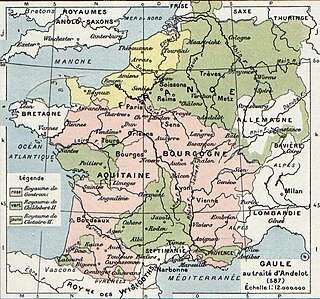
Pepin Iof Landen, also called the Elder or the Old, was the Mayor of the palace of Austrasia under the Merovingian King Dagobert I from 623 to 629. He was also the Mayor for Sigebert III from 639 until his death.

Austrasia was a territory which formed the north-eastern section of the Merovingian Kingdom of the Franks during the 6th to 8th centuries. It was centred on the Meuse, Middle Rhine and the Moselle rivers, and was the original territory of the Franks, including both the so-called Salians and Rhineland Franks, which Clovis I conquered after first taking control of the bordering part of Roman Gaul, now northern France, which is sometimes described in this period as Neustria.

Chlothar II, was king of Neustria and king of the Franks, and the son of Chilperic I and his third wife, Fredegund. He started his reign as an infant under the regency of his mother, who was in an uneasy alliance with Chlothar's uncle King Guntram of Burgundy, who died in 592. Chlothar took power upon the death of his mother in 597; though rich, Neustria was one of the smallest portions of Francia. He continued his mother's feud with Queen Brunhilda with equal viciousness and bloodshed, finally achieving her execution in an especially brutal manner in 613, after winning the battle that enabled Chlothar to unite Francia under his rule. Like his father, he built up his territories by seizing lands after the deaths of other kings.

Neustria was the western part of the Kingdom of the Franks.

Chilperic I was the king of Neustria from 561 to his death. He was one of the sons of the Frankish king Clotaire I and Queen Aregund.

Chlothar III was the eldest son of Clovis II, king of Neustria and Burgundy, and his queen Balthild. When Clovis died in 657, Chlothar succeeded him under the regency of his mother. Only a month beforehand, according to the near-contemporary Life of Eligius by the courtier Audoin (bishop) of Rouen, Saint Eligius had prophesied the death of Clovis, Balthild's downfall, and Chlothar's short reign.

Childebert II (c.570–596) was the Merovingian king of Austrasia from 575 until his death in March 596, as the only son of Sigebert I and Brunhilda of Austrasia; and the king of Burgundy from 592 to his death, as the adopted son of his uncle Guntram.
Under the Merovingian dynasty, the mayor of the palace was the manager of the household of the Frankish king.

Francia, also called the Kingdom of the Franks, Frankish Kingdom, Frankland or Frankish Empire, was the largest post-Roman barbarian kingdom in Western Europe. It was ruled by the Franks during late antiquity and the Early Middle Ages. After the Treaty of Verdun in 843, West Francia became the predecessor of France, and East Francia became that of Germany. Francia was among the last surviving Germanic kingdoms from the Migration Period era before its partition in 843.

Sigebert I was a Frankish king of Austrasia from the death of his father in 561 to his own death. He was the third surviving son out of four of Clotaire I and Ingund. His reign found him mostly occupied with a successful civil war against his half-brother, Chilperic.

Sigebert III was the Merovingian king of Austrasia from 633 to his death around 656. He was described as the first Merovingian roi fainéant —do-nothing king—, in effect the mayor of the palace ruling the kingdom throughout his reign. However he lived a pious Christian life and was later sanctified, being remembered as Saint Sigebert of Austrasia in the Roman Catholic Church and Eastern Orthodox Church.
Brunhilda was queen consort of Austrasia, part of Francia, by marriage to the Merovingian king Sigebert I of Austrasia, and regent for her son, grandson and great-grandson.

Charibert II, a son of Clotaire II and his junior wife Sichilde, was briefly King of Aquitaine from 629 to his death, with his capital at Toulouse. There are no direct statements about when Charibert was born exactly, the only known fact being that he was "a few years younger" than his half-brother Dagobert. His father Clotaire evidently had a bigamous marriage and he was the offspring of the junior wife.

Sigebert II (601–613) or Sigisbert II, was the illegitimate son of Theuderic II, from whom he inherited the kingdoms of Burgundy and Austrasia in 613. However, he fell under the influence of his great-grandmother, Brunhilda. Warnachar, mayor of the palace of Austrasia had Sigebert brought before a national assembly, where he was proclaimed king by the nobles over both his father's kingdoms. However, when the kingdom was invaded by Clotaire II of Neustria, Warnachar and Rado, mayor of the palace of Burgundy, betrayed Sigebert and Brunhilda and joined with Clotaire, recognising Clotaire as rightful regent and guardian of Sigebert and ordering the army not to oppose the Neustrians. Brunhilda and Sigebert met Clotaire's army on the Aisne, but the Patrician Aletheus, Duke Rocco, and Duke Sigvald deserted her host and Brunhilda and Sigebert were forced to flee, before being taken by Clotaire's men at Lake Neuchâtel. Brunhilda, little Sigebert and Sigebert's younger brother Corbo were executed by Clotaire's orders, and Austrasia and Neustria were reunited under Clotaire's rule, who now ruled the entire kingdom of the Franks.
Ingonde, Ingund, Ingunda, or Ingundis was a queen of the Franks by marriage to Clotaire I, son of Clovis.

Theuderic II (587–613), king of Burgundy (595–613) and Austrasia (612–613), was the second son of Childebert II. At his father's death in 595, he received Guntram's kingdom of Burgundy, with its capital at Orléans, while his elder brother, Theudebert II, received their father's kingdom of Austrasia, with its capital at Metz. He also received the lordship of the cities (civitates) of Toulouse, Agen, Nantes, Angers, Saintes, Angoulême, Périgueux, Blois, Chartres, and Le Mans. During his minority, and later, he reigned under the guidance of his grandmother Brunhilda, evicted from Austrasia by his brother Theudebert II.

Audoin was a Frankish bishop, courtier, hagiographer and saint.
Warnachar was the mayor of the palace of Burgundy (617-626) and briefly Austrasia (612-617). He began his career as the regent during Theuderic II's minority (596-c.604). In 612, when Theuderic became king of Austrasia, he became mayor of the palace. In 613, he allied with King Clotaire II of Neustria, feeling that the young Sigebert II should not be under the hated Brunhilda's influence. He betrayed Brunhilda into Clotaire's hands by instructing the army not to oppose the invading Neustrian. When Clotaire then became sole king of the Franks, he left Warnachar in power in Austrasia briefly, but confirmed at Bonneuil-sur-Marne, in 617, Warnachar's function in Burgundy until his death in 626. His son, Godinus, succeeded him.
Godinus succeeded his father Warnachar as mayor of the palace of Burgundy in 626 and held that post until 627. He married his stepmother Bertha and the king, Clotaire II, hunted him down for this. He fled to the court of Dagobert I, the king's son, in Austrasia, but Clotaire found him in Chartres and executed him.
Saint Chlodulf was bishop of Metz approximately from 657 to 697.













